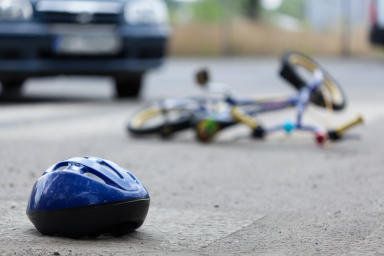Missouri Bicycle Laws

The Missouri State Highway Patrol recorded a total of 444 bicycle-related crashes throughout the state in 2022 in its Traffic Safety Compendium. Overall, the number of accidents for that year rose by over 16% compared to the recorded total in 2021. Additionally, there were 10 fatal crashes and 370 accidents that resulted in injuries, indicating an increase of more than 42% and 18% in these categories, respectively.
With fatal and injury-causing bicycle crashes still prevalent throughout Missouri, local and state government entities continue to remind bicyclists to ride safely and practice proper road etiquette. They also enforce various regulations concerning helmet use, required equipment, and bicycle operation as part of their continuing efforts to mitigate the risks riders face on the state’s roadways.
To guide those involved in an accident with another bicyclist or motorist, the Show-Me State has different laws and guidelines regarding damage caps and time limits for filing claims, as well as insurance policies that can be used to cover the losses of injured Missourians. Victims can work with a legal team to determine how these statutes and factors will affect the total amount of compensation they can recover in a personal injury claim or lawsuit.
Missouri Bicycle Helmet and Equipment Regulations
Missouri currently has no statewide law that requires bicyclists to wear helmets. However, certain municipalities have their own laws that mandate the use of helmets, most of which are located within St. Louis County. This mandate aims to help bicyclists avoid the risk of sustaining serious injuries if they are involved in an accident.
The age restrictions for helmet use vary from place to place; for example, areas such as Glendale, Bel-Ridge, and Velda City require bicyclists of all ages to wear helmets. Conversely, municipalities like Chesterfield and Normandy only require helmets for those under seventeen, while Vinita Terrace imposes restrictions for bikers aged below twenty-one. Wellston and Hillsdale are the only two localities in St. Louis County where helmets are not explicitly required. Outside the county, St. Charles and Columbia enforce regulations on helmet use for bicyclists younger than sixteen.
In terms of equipment, Missouri law states that all bicycles used during the night must have a lamp that can emit a white light up to a distance of 500 feet. This lamp can be attached to the front of a bicycle or carried by the rider. In addition, a bike must be equipped with a rear-mounted lamp able to project a red light up to 600 feet away or a red reflector with a minimum length of two square inches. These can be supplemented by reflective material on a bicycle’s sides, pedals, or crank arms, along with similar equipment on the rider’s shoes or lower legs.
Missouri’s Ordinances on the Operation of Bicycles
Missouri’s Model Vehicle Code lists a number of traffic ordinances specifically enforced for bicycles. These laws are meant to guide bicyclists and prevent accidents, and they are adopted into the municipal codes of counties and cities throughout the state. Since the state dictates that all bicyclists have the same rights and duties on the road as other motorists, they, in turn, are required to adhere to traffic regulations.
Missouri’s bicycle-related ordinances are as follows:
Bicyclists must ride to the right side of the road if they are moving slower than vehicle traffic or below the posted speed limit in that area; when leaving the right side to overtake another vehicle or make a left turn, they must exercise due care.
Bicyclists cannot ride more than two abreast if they impede the movement of other vehicles.
Bicyclists must use the required hand signals when making a turn, changing directions, or coming to a stop; they may not give continuous hand signals if they need both hands to maintain control of their bicycle.
Bicyclists cannot attach themselves to any moving vehicle on a roadway.
Bicyclists may only ride on sidewalks where they are allowed, and they must yield the right-of-way to any pedestrians present; they are also prohibited from riding on sidewalks within business districts.
Bicyclists cannot use their bike to carry more people than it is designed to handle.
Bicyclists must give pedestrians an audible signal when overtaking or passing them.
Bicyclists must obey all traffic signs and control devices.
Motor vehicle drivers in Missouri are also required to follow specific rules when navigating roads alongside bicyclists. For instance, they must maintain a safe distance at all times when passing and overtaking a bicycle, returning only to the right part of the road once it is safe to do so. Additionally, they must ensure that the road is clear of bicycles before opening the door of their vehicle.
Is Missouri a No-Fault State for Bike Accidents?
No, Missouri follows at-fault rules for accident-related matters, meaning bicycle crash victims can pursue compensation from at-fault parties using a third-party insurance claim. In most cases, offending motorists pay for a victim’s damages using their liability coverage, which they are required to have under state law.
The minimum liability coverage requirements in Missouri are:
$25,000 for the bodily injuries of one person.
$50,000 for the bodily injuries of multiple people.
$25,000 for any property damage.
In addition to liability coverage, bicycle accident victims can use uninsured and underinsured motorist coverage, which is also required under local laws. This will help an individual pay for their losses if the driver who caused the accident lacks insurance or does not have enough to cover their damages. The minimum required amounts for uninsured and underinsured motorist coverage are also $25,000 for one person's injuries and $50,000 for the injuries of multiple people.
How Much Can Someone Sue for a Bicycle Accident in Missouri?
People who are involved in bicycle accidents in Missouri are entitled to recover compensatory damages, which come in the form of economic and noneconomic losses. The state does not have any caps on the total compensatory payments that can be obtained through a claim or lawsuit in an accident, since its only cap is for noneconomic damages in medical malpractice cases. This allows a plaintiff to maximize the compensation they can pursue from at-fault parties.
Economic damages are classified as calculable monetary losses an accident victim has suffered as a result of their injury. Examples of these losses include present and future medical expenditures, lost income, and repair costs for damaged property. They can also include additional expenses for rehabilitative care and housekeeping services for tasks the victim cannot do due to their injury.
On the other hand, noneconomic damages are intangible losses that are influenced by the physical pain and mental anguish stemming from a victim’s injuries. Examples of these are loss of companionship, diminished quality of life, and emotional distress. Missouri courts calculate noneconomic damages based on factors like the severity and duration of the victim’s injuries, as well as their impact on the victim’s mental health and daily life.
While Missouri does not limit compensatory damages, it does deduct a victim’s potential compensation under the rule of pure comparative fault. This applies if the court finds that a plaintiff is partially to blame for the accident in question, with the percentage of deducted damages equaling the percentage of their liability. For example, a plaintiff who is 25% at fault will have 25% deducted from a damage award worth $200,000, leaving them with only $150,000. However, unlike in scenarios involving modified comparative fault, a person can still recover damages even if they are 99% liable under pure comparative fault rules.
What Is Missouri’s Statute of Limitations for Bicycle Accidents?
Under Missouri’s statute of limitations for personal injury matters, bike accident victims have up to five years to take legal action against any at-fault parties, starting from the date of the accident. The same duration applies if an accident results only in property damage. In the event a victim dies from injury, their representative or dependents have a maximum of three years to file a wrongful death claim, starting from the date of the victim’s death.
There are certain circumstances where Missouri’s statute of limitations is paused or starts at a different time. This often occurs if the person entitled to file a claim or lawsuit in an accident case is a minor or deemed mentally incapacitated. State law dictates that the statute will only begin once the person in question reaches the age of 21 or recovers from their mental disability.
Other exceptions to the statute involve cases where the defendant is absent from the state or leaves before any legal action can be taken against them. In these scenarios, the statute will only begin once the defendant returns to the state. Additionally, if they leave after the statute has begun counting down, the period of their absence may not be counted as part of the statute’s duration.
Legal Resources for Missouri Bicycle Accident Victims
The Missouri Bar
The Missouri Bar’s website is open to individuals who seek legal help or basic information concerning local laws and regulations. It has an official lawyer directory that Missourians can use to search for specific attorneys who are in good standing with the Supreme Court of Missouri. Its Lawyer Search section also allows residents with legal concerns to find attorneys who are accepting new clients within their specific city or county. Additionally, the website provides access to the Legal Topics section, where visitors can read and download online resources discussing various areas of the law. Furthermore, those who wish to file a complaint against a judge or lawyer for ethical misconduct may visit the Dispute Resolution Programs section for information on how to do so.
Missouri State Highway Patrol - Crash Report Requests
Missourians involved in traffic accidents can visit the State Highway Patrol’s website for directions on how to submit requests for injury and fatal accident reports. Those who plan to submit a request must download, print, and complete the Traffic Crash Report Form. Each report copy costs $5.99, which can be paid using a check or money order payable to the DPS - Missouri State Highway Patrol. Requests must be sent along with the required payment to the Patrol Records Division via P.O. Box 568 in Jefferson City. For additional questions and clarifications, people can contact the division by dialing (573) 522-2590.
Missouri Department of Transportation - Bicycle and Pedestrian Resources
The MoDOT website has a directory of links to both local and national resources for bicyclists and pedestrians alike. People can access these resources to learn about relevant traffic guidelines and regulations throughout the state, recorded statistics on bicycle and pedestrian safety, and federal requirements on bike parts and equipment. They can also use the directory to find and visit the websites of local and national organizations, including the St. Joseph Bicycle Club, BikeWalk KC, the League of American Bicyclists, and the Association of Pedestrian & Bicycle Professionals.
Expertise.com StaffAuthor
Step into the world of Expertise.com, your go-to hub for credible insights. We don't take accuracy lightly around here. Our squad of expert reviewers, each a maestro in their field, has given the green light to every single article you'll find. From rigorous fact-checking to meticulous evaluations of service providers, we've got it all covered. So feel free to dive in and explore. The information you'll uncover has been stamped with the seal of approval by our top-notch experts.




